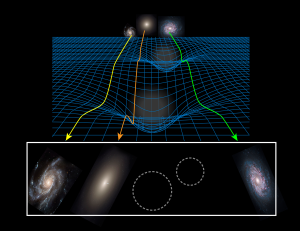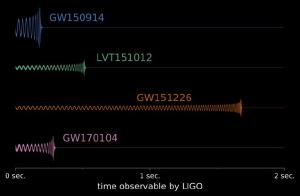Blog
Bending the Wave
8 October 2020
Gravity is a strange thing. In our everyday lives, we think of it as a force. It pulls us to the Earth and holds planets in orbits around their stars. But gravity isn’t a force. It is a warping of space and time that bends the trajectory of objects. Throw a ball in deep space, and it moves in a straight line following Newton’s First Law of Motion. Throw the same ball near the Earth’s surface, and it follows a parabolic trajectory caused by Earth’s warping of spacetime around it.
Because matter bends space, it can deflect the path of light as well. We call this effect gravitational lensing. It typically happens when light from a distant galaxy or quasar is deflected by the mass of a closer galaxy along its path to us. Gravitational lensing can focus light, making a distant galaxy appear brighter, and this has helped us observe some of the most distant galaxies.
 ESA–C.Carreau
ESA–C.CarreauMatter’s warping of space can also produce gravitational waves as matter moves through space, like ripples in a pond. Most of these gravitational ripples are too small to detect, but we can see strong waves caused by black hole mergers. By observing the waves of several mergers, we have confirmed that gravitational waves travel at the speed of light just as predicted by general relativity. And this means gravity can also deflect its own waves.
 APS/Alan Stonebraker
APS/Alan StonebrakerGravitational waves and light both travel at the same constant speed in a vacuum. Their paths can be deflected because this speed is finite. It takes time for the waves to travel a certain distance. When a galaxy or black hole warps its surrounding space, the portion of a wave near the object has to travel slightly farther than the rest of the wave, so it takes slightly longer to reach us. As a result, the wave is deflected toward the mass. So when merging black holes send us a burst of gravitational waves, those waves could be lensed by closer galaxies.
 LIGO/Caltech/MIT/University of Chicago (Ben Farr)
LIGO/Caltech/MIT/University of Chicago (Ben Farr)At least that’s the theory. Recently a team looked at this effect and how it would change the appearance of gravitational wave events.1 They found a couple of interesting things. The first is that lensed gravitational waves would make the source appear closer than it actually is, similar to the way lensed light can appear brighter. This could have significant implications for the gravitational mergers we’ve observed since astronomers are using their distances to measure the scale and expansion of the universe. But the team also found that lensed merger events would have a distinctly different overall shape, so we can in principle tell the difference between lensed and unlensed gravitational waves. Looking at the black hole mergers LIGO and VIRGO have detected so far, they found none of them were gravitationally lensed.
It will be a while before we can really study lensed gravitational waves. While the effects are clear, they will require more sensitive gravitational wave observatories to see them in detail. But this work shows how gravitational wave astronomy will provide a wealth of information to astronomers in time.
Buscicchio, Riccardo, et al. “Constraining the lensing of binary black holes from their stochastic background.” Physical Review Letters 125.14 (2020): 141102. ↩︎